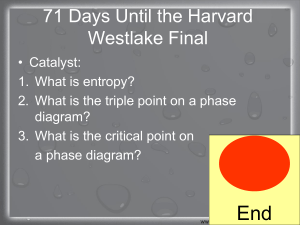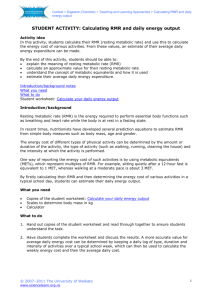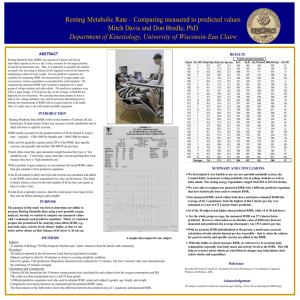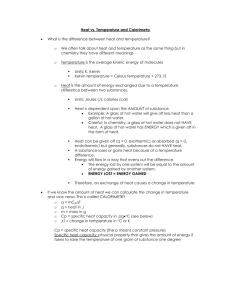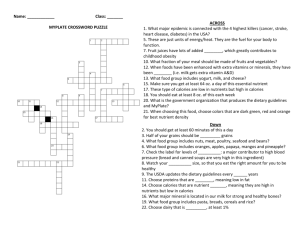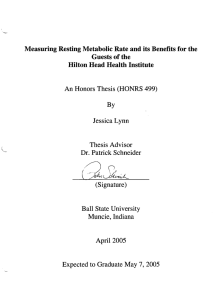Indirect Calorimetry & Nutrition Evaluation
advertisement
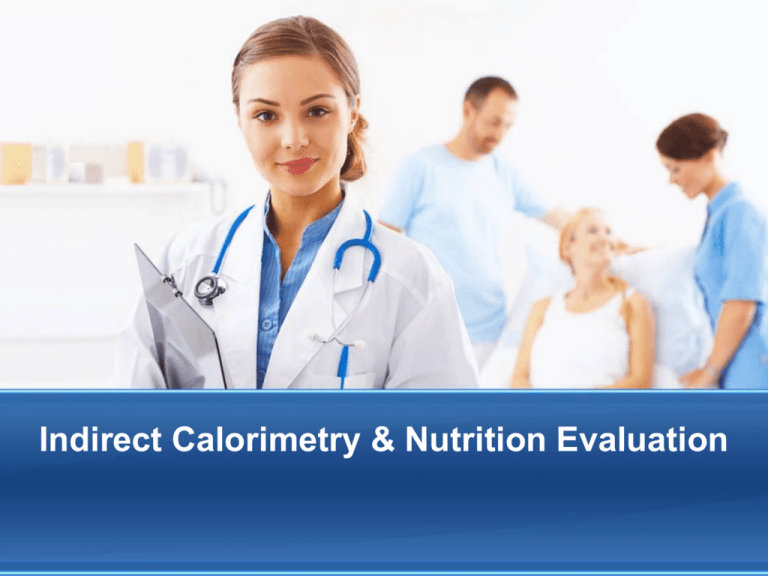
Indirect Calorimetry & Nutrition Evaluation Objectives • Explain Energy Balance • Understand basic physiology and factors that affect metabolism • Determine Calorie Needs • Indirect Calorimetry Integration • Case Studies • RMR implementation into practice • Practical instruction Losing weight It’s All About Calories Maintain weight by eating what you burn Diet Adkins: Zone: Low Fat (WW): • Gain weight by eating more than you burn Carbohydrates 300 calories 600 calories 800 calories Lose weight by eating less than you burn Protein Fat 700 calories 500 calories 450 calories 450 calories 500 calories 300 calories Total 1500 calories 1500 calories 1500 calories “Weight loss with any popular diets are similar…..” (Dansinger, et al. 2005; JAMA). Energy Balance Literacy • Americans are consuming more food than they think. Most overweight individuals under-report food consumed vs. activity energy expenditure.1-3 • According to the 2000 U.S. food consumption report, adults an estimated 2,700 calories per day. This is 700 calories more than recommended. • When asked how many calories is recommended per day approximately 65% of adults guessed correctly. 4 • According to Weight Management Guidelines one of the top education topics is understanding food labels and portion sizes. 5 1. Molag, M. L., et al. (2007). Am J Epidemiol, 166(12), 1468-1478. 2. Scagliusi, F. B., et al. . (2003). JADA, 103(10), 1306-1313. 3. Schaefer, E. J., et al. (2000). Am J Clin Nutr, 71(3), 746-751. 4. Nelson, M. C., Lytle, L. A., & Pasch, K. E. (2009). JADA, 109(2), 281-287. 5. NIH. (2000). Practical guide to the identification, evaluation, and treatment of overweight and obesity in adults. Definition of Metabolism • Metabolism = the biochemical process of breaking down food to release the energy needed for the body to function • The amount of energy is commonly expressed in Kcals. • Kcal= approximates the energy needed to increase the temperature of 1 kilogram of water by 1 °C Metabolic pathways • Two metabolic pathways exist to produce energy (ATP) and heat. • 1. Aerobic Metabolism (Oxidative): With oxygen (O2) • predominant source of energy production. At rest and during activity • 2. Anaerobic Metabolism (Non-oxidative): Without O2 • Short durations for intense activities, a very small part of the total energy production (very inefficient) Aerobic Metabolism Foodstuff Respiration O2, N ATP + Heat O2, N, Co2 TEE • Total Energy Expenditure (TEE): anaerobic & aerobic metabolism. • Comprised of: 1. Resting Metabolic Rate (est. 75%) 2. Thermic Effect of Food (est. 5%) 2. Lifestyle (est. 20%) 3. Purposeful Activity (est. 5-10%) TEE Exercise TEF Lifestyle RMR Resting Metabolic Rate • Resting metabolic rate (RMR): calories your body burns with no activity. Approx. 60-75% of TEE for most individuals and up to100% in critically ill patients. • RMR is unique to each person and is affected by a number of factors including: • Age • Body weight • Body composition • Medications • Fever and/or Infection • Weight loss • Exercise • Gender • Genetics (UCP1 & 2 gene) • Hormones (testosterone, leptin) • Nutritional Supplements (Caffeine, Ephedra, Synephrine) • Caloric restriction Danforth, E. Life Sci 1981.28; 1821-1827 Fung, E. AACN Clinical Issues 2000. 11(4); 480-497 Compher, C. JADA 2006. 106(6); 881-903 Yanovski, J.A., et al. Am J Clin Nutr, 2000. 71(6): p. 1405-1420. How to Determine Calorie Needs in Clinical Practice? • Option 1: Use Standard Recommendations • Option 2: Estimate Calorie Needs • Option 3: Use Indirect Calorimetry 1. Standard Recommendations • Recommendations: 1200 Kcal/day women & 1600 Kcal/day men. 1 • Weight loss is usually 50% less than predicted. 2-3 • Low adherence rates (50-80% attrition). 4 • Patients want individualized treatment. 5-6 1. 2. 3. 4. 5. 6. NIH. (2000). Practical guide to the identification, evaluation, and treatment of overweight and obesity in adults. Heymsfield, S. B., et al. (2007). Am J Clin Nutr, 85(2), 346-354. McDoniel, S. O., & Hammond, R. S. (2010).. Int J Clin Pract, 64(11), 1503-1511 Dansinger, M. L., et al. (2005).. Jama, 293(1), 43-53. Bearn, et al..(2008) Am J Life Med. 2(1) 75.. Tan, et al.(2006) Med J Aust. 18592). 73. 2. Estimate Calorie Needs Foster et al (1988) evaluated the metabolic differences of like individuals. (Figure 2). Subjects of Similar Height and Weight RMR 1263 1523 1778 1979 2152 RMR can vary significantly between similar individuals – up to 900 Kcals/day Foster et al. Metabolism 1988. 37(5); 467-472. Equations • Mifflin-St Jeor, 1990 • Men: RMR=9.99 X weight+6.25 X height4.92 X age + 5 • Women: RMR=9.99 X weight + 6.25 X height4.92 X age -161 • Harris Benedict, 1919 • Men: RMR= 66.47+13.75 X weight+5.0 X height- 6.75X age • Women: RMR= 665.09 + 9.56 X weight +1.84 X height - 4.67 X age • Owen, 1986-87 • Men: RMR=879 X 10.2 X weight. • Women: RMR=795 + 7.18 X weight. RMR = resting metabolic rate in kcal/day, Weight in kg, Height in cm Equations RMR = resting metabolic rate in kcal/day, Weight in kg, Height in M Height & Weight 180 cm (5Ft 11 Inches) 180 cm (5Ft 11 Inches), 220 lbs 220 lbs 1lb muscle burns 3 to 4 times as much kcal/day as 1lb fat Race/Etnicity Hasson et al. Journal of Science and Medicine in Sport 14 (2011) 344–351 Equations are based on averages not precise for individuals Hasson et al. Journal of Science and Medicine in Sport 14 (2011) 344–351 3. (In)direct Calorimetry • The body uses oxygen for the sole purpose of oxidizing food. • oxygen consumed = oxygen used to burn calories. (the body does not store oxygen) • There is a mathematical relationship between oxygen consumption and calories burned. Mault, J. Nutrition in Comprehensive Respiratory Care 1995. 589-601 Direct calorimetry Specialized chamber Cleveland Clinic Center for Medical Art & Photography • • • • Gold standard Measurement takes an hour Very expensive Logistically impractical (time, space etc) Metabolic cart • Requires dedicated space • Routine calibration needed • Accurate and well-accepted in clinical settings • Cost: $30-50,000 Indirect calorimetry Douglas bag method Douglas bag method Cleveland Clinic Center for Medical Art & Photography • Easier • Measurement 5-15 min • High costs for equipment used for analysis • $15-30,000 Handheld Indirect calorimetry MedGem • • • • Portable Easy to analyze Very cost-effectiveness Costs $4,000 Medgem vs. Douglas bag Nieman et al. J Am Diet Assoc. 2003;103: 588-593. Clinical evidence Conclusions Medgem • • • • Provides valid and reliable measurements of RMR Shows high reproducibility Suitable for children (>8 years) Less suitable for patients with cancer and anorexia nervosa • MedGem guided diet leads to more weight loss as compared to usual care • More accurate than predictive equations based on gender, age, and ethnicity for determining resting metabolic rate • A viable alternative for clinical evaluation of the hospitalized patient Medgem: How does it work? Indirect Calorimetry • Indirect calorimeters convert gas exchange (VO2 & VCO2) measurements into metabolic rate (calories). Calories = (VO2*Fixed Factor) + (VCO2*Fixed Factor)– Nitrogen Foodstuff Respiration O2, N Weir, J. Phys 1949. 109:; 1-9 ATP + Heat O2, N, Co2 Respiratory Quotient • Resting Metabolic Rate = [(3.941)(VO2 ) + (1.106)(VCO2)] • The Medgem only measures VO2 not VCO2 • Therefore the formula needs to be modified • Respiratory Quotient (RQ) = VCO2 eliminated / VO2 consumed • Thus VCO2 = VO2 * RQ • Resting Metabolic Rate = [(3.941)(VO 2 ) + (1.106)(VO2)(RQ)] Respiratory Quotient • RQ’s differ for energy substrates, but on average ≈0.85 (1.00 + 0.82 + 0.71)/3 ≈ 0.85 Why Use Indirect Calorimetry? • It gives you and the patient accurate data for energy expenditure. • Studies show patients who know their RMR have better weight loss success. 1 • Patient’s believe RMR assessment is an important part to their weight management program. 2 • Evidence-based & Guideline Solution for determining calorie needs. 3-4 • No more excuse, “I can’t lose weight because it’s my metabolism”. 1. McDoniel, S., et al. (2008) Obese Facts, 1(6); 298-304 2. Chambliss, H., et al. (2011) Patient Education & Counseling. [Epub ahead of print]. doi:10.1016/j.pec.2010.12.024 3. Adult Obesity Taskforce Guideline 2011: HealthTeamWorks 4. Adult Weight Management Guideline: American Dietetic Association. MedGem in practice, does it work? The Biggest Loser Uses Medgem Reimbursement Obesity is likely to be denied by payers unless the patient has an underlying medical condition related to obesity. Obesity should be listed as the secondary disease. Sample criteria for determining medical necessity for indirect calorimetry (ICD-9-CM codes). Similar coding as spirometry. Average payer reimbursement is $50-70.00. • • • • • 414 Chronic Pulmonary HT disease* 428 Heart Failure* 493 Asthma* 496 COPD* 517.8 Lung involvement in other disease* • 780. 5 Obstructive Sleep Apnea* • 786.5 Dyspnea* • 786.9 Hypoventilation Syndrome* * CMS indicates medical necessity. . • • • • • • • • • 244.9 250 272.1 272.4 277.7 278 401 414 783.1 Hypothyroidism Diabetes Mellitus Hypercholesterolemia Hyperlipidemia Metabolic Syndrome Obesity Hypertension Cardiovascular Disease Abnormal weight gain Medical costs obesity Cowly et al. obesity reviews 2011 Medgem in practice Indirect Calorimetry Protocol •Be fasting (> 5 hrs) •Not exercised (> 2-5 hrs) •Not consumed stimulants •Not used nicotine •Rest for 10-20 min before measurement Compher, et al. (2006) JADA. 106(6); pp881-903. It’s all about calories • 500 Kcal/day ≈ 1lb / week (general assumption) • ♂ 350 Kcal/day ≈ 1lb / week 1-2 • ♀ 490 kcal/day ≈ 1lb / week 1-2 Pietrobelli et al. Int J Obes Relat Metab Disord 2002 Hal et al. In J Obes (lond) 2008 “Energy Balance Literacy” Case Study: RA 68 year old male with a BMI of 41.4 (kg/m2). He has OSAS (AHI 89.1) and metabolic syndrome (HTN 145/97, LDL 124 mg/dl, CHOL 267 mg/dl). RA indicates that he desires to lose weight and has tried self-help diets and WW in the past. He has lost weight at WW but regained all the weight. • Current Weight: 309 lbs • Dx: OSAS, Metabolic Syndrome, & Obesity • Patient desires to lose weight. • IC procedure is warranted • Pharmacotherapy is warranted • Discuss bariatric surgery. RA’s Personalized Program 6 Month Weight Goal: 225 lbs V02: 386 ml/min 2.7 ml/kg (Normal: 2.4-3.2) RMR: 2400 Kcal For RA to lose 50 lbs over the next 24 weeks he will need to have an energy deficit of 1000 Kcals/ day TEE 3120 Kcals/day Weight Loss (2 lb/week) - 1000 Kcals/day Daily calorie needs w/o exercise: 2120 Kcals/day Energy Plan is 12% below his basic physiologic needs When Measure? • At the beginning of a weight loss program to improve energy balance literacy. • If a patient plateaus &/or if a patient loses 10% of their body weight • When the patient reaches their goal weight • Annually Reimbursement or Cash? • No guarantee for insurance reimbursement • You may bill for your time (E/M 99211-99214) to do the procedure • You may bill for the procedure (CPT 94690) • Average reimbursement varies per payer ($50-70) • Cash Pay: $75 - $125 Program Options • Add RMR measurement to a package program • hCG + appointments + RMR + ??? • Individual RMR measurements • May consider having patient pay for RMR in advance – pay for now so you can have them come back for their annual visit. • Gives you a reason to get the patient back in your office!


